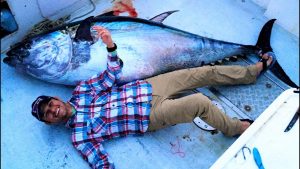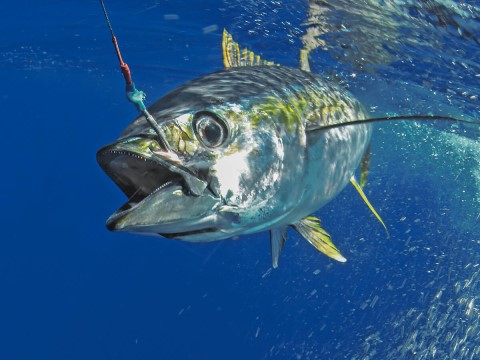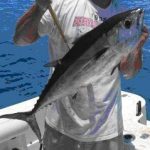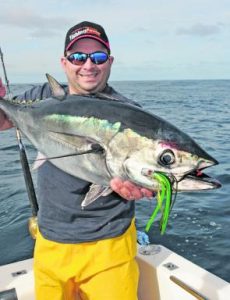What is the Best Bait for Skipjack Tuna
Skipjack tuna, also known as Katsuwonus pelamis, is a small tuna species mainly found in tropical and subtropical waters around the world. Their feeding time occurs in the late afternoon. During this time, they will swarm in large schools to feed on baitfish on the ocean surface. Skipjack tunas eat various types of fishes in their diets including anchovies, mackerels, and herrings.
For skipjack tuna, most fishermen would use artificial lures to catch them. Examples of artificial baits that have produced good results are plastic skirts, shiny metal spoon, plastic squid, lead-head jigs, bibless minnows, pilchards, and other soft plastics. You have to experiment yourself to find out the best size and color of artificial lures to catch them.
You can also catch tuna with a real bait. If you want to use real bait, you should use live baits like anchovies, mackerel, sand eels and sardines. Dead baits can be used too but a bait that is alive will be better as it will be able to move and generate some actions in the water.
The most popular method of catching skipjack tuna is trolling with 2 – 4 lures. The speed at which you are trolling is very important. When using small lures, you should troll at 4 – 6 knots. While trolling, you are to look out for Skipjack feeding on the surface. One easy way to spot them is to look out for diving birds like Gannets. When you spot them, cast your fishing line just in front of school taking care that there is a distance away.
There should be at least four rods set up in your boat, with the lures on 2 rods reaching as far as 30 m and the lures on the other 2 rods reaching as close as 15 m. If you only have 2 rods, you can set up one to 30 m and the other one to cover up to 15m. In this way, you will have covered the nearer and further areas when the skipjack swim towards your boat.
Hiring a fishing charter with modern technology is a must. But, you must also be educated with basics like knowing what different behavior of birds mean and knowing how to read the SST chart. Reading the SST chart allows you to find out about the sea current movement to find out where the tuna is traveling.
Before setting out, make sure you are equipped with with a large spinning reel that can be spooled up to a long distance. The reason is that skipjack tuna is a good swimmer and it will swim at a high speed when caught. Equipping yourself with a long spinning reel ensures a smooth drag.
Most of the Skipjack tuna that are caught weigh in the range of 5 – 15 pounds. They fight hard when being caught so you must know how to handle it. As soon as it is killed, you must place it on the ice otherwise you may suffer from scombrois poisoning when eating the meat.

 Penn Tuna Fishing Rod & Reel Combo
Penn Tuna Fishing Rod & Reel Combo Stainless Steel Fishing Leaders
Stainless Steel Fishing Leaders View Best Tuna Fishing Lures
View Best Tuna Fishing Lures
 Saltwater Trolling Lure for Tuna
Saltwater Trolling Lure for Tuna Tuna Fishing Shirt
Tuna Fishing Shirt
 Cedar Plugs Tuna Fishing Lures
Cedar Plugs Tuna Fishing Lures Fishing Rod Holder
Fishing Rod Holder Lures Bait Rig Or Hooks
Lures Bait Rig Or Hooks Chum Bag
Chum Bag  Fishing Bait Bag
Fishing Bait Bag 3pcs Bait Bag Chum Bucket
3pcs Bait Bag Chum Bucket

 Blue Fly Fish Saltwater Trolling Fishing Lures
Blue Fly Fish Saltwater Trolling Fishing Lures Rigged Trolling Flexi Spreader Bar Topwater
Rigged Trolling Flexi Spreader Bar Topwater 36″ Skipjack Hybrid UV 8″ Blue & Pink Mackerel Baits
36″ Skipjack Hybrid UV 8″ Blue & Pink Mackerel Baits Mini Spreader Bar
Mini Spreader Bar